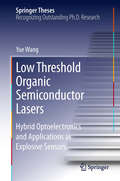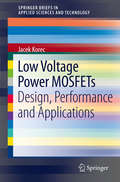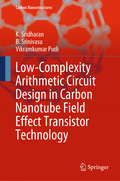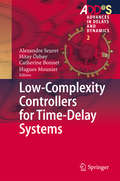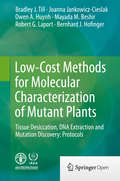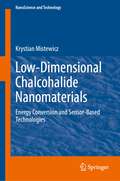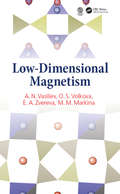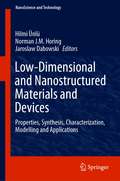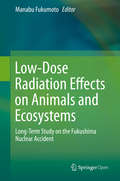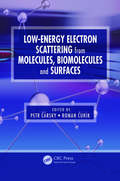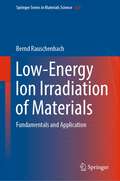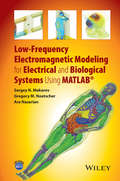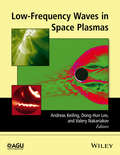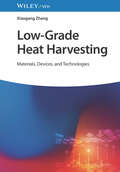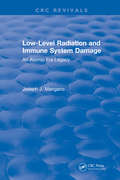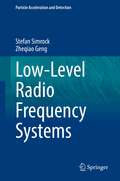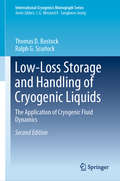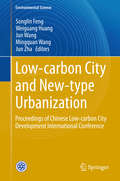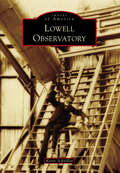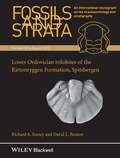- Table View
- List View
Low Threshold Organic Semiconductor Lasers
by Yue WangThis thesis focuses on two areas - the development of miniature plastic lasers that can be powered by LEDs, and the application of these lasers as highly sensitive sensors for vapours of nitroaromatic explosives (e. g. TNT). Polymer lasers are extremely compact visible lasers; the research described in the thesis is groundbreaking, driving forward the technology and physical understanding to allow these lasers to be routinely pumped by a single high-power LED. A notable advance in the work is the demonstration of nanoimprinted polymer lasers, which exhibit the world's lowest pump threshold densities by two orders of magnitude. The thesis also advances the application of these compact, novel lasers as highly sensitive detectors of explosive vapours, demonstrating that rapid detection can be achieved when microporous polymers are used. This work also demonstrates a prototype CMOS-based microsystem sensor for explosive vapours, exploiting a new detection approach.
Low Voltage Electron Microscopy
by David C. Bell Natasha ErdmanPart of the Wiley-Royal Microscopical Society Series, this book discusses the rapidly developing cutting-edge field of low-voltage microscopy, a field that has only recently emerged due to the rapid developments in the electron optics design and image processing.It serves as a guide for current and new microscopists and materials scientists who are active in the field of nanotechnology, and presents applications in nanotechnology and research of surface-related phenomena, allowing researches to observe materials as never before.
Low Voltage Power MOSFETs
by Jacek KorecLow Voltage Power MOSFETs focuses on the design of low voltage power MOSFETs and the relation between the device structure and the performance of a power MOSFET used as a switch in power management applications. This SpringerBriefs close the gap between detailed engineering reference books and the numerous technical papers on the subject of power MOSFETs. The material presented covers low voltage applications extending from battery operated portable electronics, through point of load converters, internet infrastructure, automotive applications, to personal computers and server computers. The issues treated in this volume are explained qualitatively using schematic illustrations, making the discussion easy to follow for all prospective readers.
Low-Complexity Arithmetic Circuit Design in Carbon Nanotube Field Effect Transistor Technology (Carbon Nanostructures)
by K. Sridharan Vikramkumar Pudi B. SrinivasuThis book introduces readers to the emerging carbon nanotube field-effect transistor (CNTFET) technology, and examines the problem of designing efficient arithmetic circuits in CNTFET technology. Observing that CNTFETs make it possible to achieve two distinct threshold voltages merely by altering the diameter of the carbon nanotube used, the book begins by discussing the design of basic ternary logic elements. It then examines efficient CNTFET-based design of single and multiple ternary digit adders by judicious choice of unary operators in ternary logic, as well as the design of a ternary multiplier in CNTFET technology, and presents detailed simulation results in HSPICE. Lastly, the book outlines a procedure for automating the synthesis process and provides sample code in Python.
Low-Complexity Controllers for Time-Delay Systems
by Hitay Özbay Alexandre Seuret Catherine Bonnet Hugues MounierThis volume in the newly established series Advances in Delays and Dynamics (ADD@S) provides a collection of recent results on the design and analysis of Low Complexity Controllers for Time Delay Systems. A widely used indirect method to obtain low order controllers for time delay systems is to design a controller for the reduced order model of the plant. In the dual indirect approach, an infinite dimensional controller is designed first for the original plant model; then, the controller is approximated by keeping track of the degradation in performance and stability robustness measures. The present volume includes new techniques used at different stages of the indirect approach. It also includes new direct design methods for fixed structure and low order controllers. On the other hand, what is meant by low complexity controller is not necessarily low order controller. For example, Smith predictor or similar type of controllers include a copy of the plant internally in the controller, so they are technically infinite dimensional. However, they have very nice numerical properties from the point of reliable implementation. Therefore, such predictor-based controllers are considered as low complexity. This book includes new predictor-based design techniques, with several application examples.
Low-Cost Methods for Molecular Characterization of Mutant Plants
by Joanna Jankowicz-Cieslak Bradley J. Till Owen A. Huynh Mayada M. Beshir Robert G. Laport Bernhard J. HofingerThis book offers low-cost and rapid molecular assays for the characterization of mutant plant germplasm. Detailed protocols are provided for the desiccation of plant tissues; the extraction of high-quality DNA for downstream applications; the extraction of single-strand-specific nucleases for single nucleotide polymorphism; and small insertion/deletion discovery using standard agarose gel electrophoresis. The methods described can be applied in any laboratory equipped for basic molecular biology and do away with the need for expensive freezers and toxic organic compounds. With the appropriate validation of sample quality and longevity, they can provide sufficient DNA for a variety of molecular applications, such as marker studies and TILLING, at approximately one tenth of the cost per sample when compared to commercial kits.
Low-Dimensional Chalcohalide Nanomaterials: Energy Conversion and Sensor-Based Technologies (NanoScience and Technology)
by Krystian MistewiczThis book provides a deep insight into recent achievements in synthesis, investigation, and applications of the low-dimensional chalcohalide nanomaterials. The large number of interesting phenomena occur in these compounds, including ferroelectric, piezoelectric, pyroelectric, electrocaloric, Seebeck, photovoltaic, and ferroelectric-photovoltaic effects. Furthermore, the outstanding photoelectrochemical, photocatalytic, and piezocatalytic properties of the chalcohalide nanomaterials have been revealed. Since many chalcohalide semiconductors possess both photoactive and ferroelectric properties, they are recognized as photoferroelectrics. It presents an overview of fabrication of chalcohalide nanomaterials using different methods: mechanical milling of bulk crystals, liquid-phase exfoliation, vapor phase growth, hydro/solvothermal methods, synthesis under ultrasonic irradiation, microwave synthesis, laser/heat-induced crystallization, electrospinning, successive ionic layer adsorption and reaction. The strategies of the chalcohalide nanomaterials processing for construction of functional devices are presented.The book describes solution processing for thin films preparation, spin-coating deposition of polymer composites, solution casting, films deposition via drop-casting, high pressure compression of nanowires into the bulk samples, pressure assisted sintering, and electric field assisted alignment of nanowires. The applications of the chalcohalide nanomaterials for mechanical/thermal energy harvesting and energy storage are presented. Major challenges and emerging trends in fabrication, characterization, and future applications of low-dimensional chalcohalide nanomaterials are discussed. A wealth of information for scholars, graduate students, and engineers involved in research of nanomaterials.
Low-Dimensional Functional Materials
by Davron Matrasulov Reinhold Egger Khamdam RakhimovMaintaining and improving energy security is one of the biggest challenges worldwide. The NATO ARW conference in Tashkent, October 2012, was devoted to discussing visions and concepts that are currently discussed in different research fields. Leading scientists have written concise contributions to introduce the reader to this exciting topic. The present volume summarizes the discussions at the conference.
Low-Dimensional Magnetism
by A. N. Vasiliev O. S. Volkova E. A. Zvereva M. M. MarkinaLow-dimensional magnetism physics involves the search for new magnetic compounds and improving their characteristics to meet the needs of innovative technologies. A comprehensive overview of key materials, their formulation data and characteristics are detailed by the author. <P><P>Key selling features: Explores dominant mechanisms of magnetic interaction to determine the parameters of exchange interactions in new magnetic materials. Describes how magnetism and superconductivity not only compete, but also "help" each other. Details characteristics of key materials in the magnetic subsystem. Results of several internationally renowned research groups are included and cited. Suitable for a wide range of readers in physics, materials science, and chemistry interested in the problems of the structure of matter.
Low-Dimensional and Nanostructured Materials and Devices: Properties, Synthesis, Characterization, Modelling and Applications (NanoScience and Technology)
by Hilmi Ünlü Norman J. M. Horing Jaroslaw DabowskiThis book focuses on the fundamental phenomena at nanoscale. It covers synthesis, properties, characterization and computer modelling of nanomaterials, nanotechnologies, bionanotechnology, involving nanodevices. Further topics are imaging, measuring, modeling and manipulating of low dimensional matter at nanoscale. The topics covered in the book are of vital importance in a wide range of modern and emerging technologies employed or to be employed in most industries, communication, healthcare, energy, conservation , biology, medical science, food, environment, and education, and consequently have great impact on our society.
Low-Dose Radiation Effects on Animals and Ecosystems: Long-Term Study on the Fukushima Nuclear Accident
by Manabu FukumotoThis open access book summarizes the latest scientific findings regarding the biological effects of the Fukushima Daiichi Nuclear Power Plant (FNPP) accident in 2011.Various cases of changes in animals and organisms have been reported since the FNPP accident. However, it is often unknown whether they are actually due to radiation, since the dose or dose-rate are not necessarily associated with the changes observed. This book brings together the works of radiation biologists and ecologists to provide reliable radioecology data and gives insight into future radioprotection.The book examines the environmental pollution and radiation exposure, and contains valuable data from abandoned livestock in the ex-evacuation zone and from wild animals including invertebrates and vertebrates, aqueous and terrestrial animals, and plants that are subjected to long-term exposure in the area still affected by radiation. It also analyzes dose evaluation, and offers new perspectives gained from the accident, as well as an overview for future studies to promote radioprotection of humans and the ecosystem.Since the biological impact of radiation is influenced by various factors, it is difficult to scientifically define the effects of low-dose/low-dose-rate radiation. However, the detailed research data presented can be combined with the latest scientific and technological advances, such as artificial intelligence, to provide new insights in the future.This book is a unique and valuable resource for researchers, professionals and anyone interested in the impact of exposure to radiation or contamination with radioactive materials.
Low-Energy Electron Scattering from Molecules, Biomolecules and Surfaces
by Petr ČárskY Roman ČURíSince the turn of the 21st century, the field of electron molecule collisions has undergone a renaissance. The importance of such collisions in applications from radiation chemistry to astrochemistry has flowered, and their role in industrial processes such as plasma technology and lighting are vital to the advancement of next generation devices. F
Low-Energy Ion Irradiation of Materials: Fundamentals and Application (Springer Series in Materials Science #324)
by Bernd RauschenbachThis book provides a comprehensive introduction to all aspects of low-energy ion–solid interaction from basic principles to advanced applications in materials science. It features a balanced and insightful approach to the fundamentals of the low-energy ion–solid surface interaction, focusing on relevant topics such as interaction potentials, kinetics of binary collisions, ion range, radiation damages, and sputtering. Additionally, the book incorporates key updates reflecting the latest relevant results of modern research on topics such as topography evolution and thin-film deposition under ion bombardment, ion beam figuring and smoothing, generation of nanostructures, and ion beam-controlled glancing angle deposition. Filling a gap of almost 20 years of relevant research activity, this book offers a wealth of information and up-to-date results for graduate students, academic researchers, and industrial scientists working in these areas.
Low-Frequency Electromagnetic Modeling for Electrical and Biological Systems Using MATLAB
by Gregory M. Noetscher Ara Nazarian Sergey N. MakarovProvides a detailed and systematic description of the Method of Moments (Boundary Element Method) for electromagnetic modeling at low frequencies and includes hands-on, application-based MATLAB® modules with user-friendly and intuitive GUI and a highly visualized interactive output. Includes a full-body computational human phantom with over 120 triangular surface meshes extracted from the Visible Human Project® Female dataset of the National library of Medicine and fully compatible with MATLAB® and major commercial FEM/BEM electromagnetic software simulators. This book covers the basic concepts of computational low-frequency electromagnetics in an application-based format and hones the knowledge of these concepts with hands-on MATLAB® modules. The book is divided into five parts. Part 1 discusses low-frequency electromagnetics, basic theory of triangular surface mesh generation, and computational human phantoms. Part 2 covers electrostatics of conductors and dielectrics, and direct current flow. Linear magnetostatics is analyzed in Part 3. Part 4 examines theory and applications of eddy currents. Finally, Part 5 evaluates nonlinear electrostatics. Application examples included in this book cover all major subjects of low-frequency electromagnetic theory. In addition, this book includes complete or summarized analytical solutions to a large number of quasi-static electromagnetic problems. Each Chapter concludes with a summary of the corresponding MATLAB® modules. Combines fundamental electromagnetic theory and application-oriented computation algorithms in the form of stand alone MATLAB® modules Makes use of the three-dimensional Method of Moments (MoM) for static and quasistatic electromagnetic problems Contains a detailed full-body computational human phantom from the Visible Human Project® Female, embedded implant models, and a collection of homogeneous human shells Low-Frequency Electromagnetic Modeling for Electrical and Biological Systems Using MATLAB® is a resource for electrical and biomedical engineering students and practicing researchers, engineers, and medical doctors working on low-frequency modeling and bioelectromagnetic applications.
Low-Frequency Waves in Space Plasmas
by Andreas Keiling Dong-Hun Lee Valery NakariakovLow-frequency waves in space plasmas have been studied for several decades, and our knowledge gain has been incremental with several paradigm-changing leaps forward. In our solar system, such waves occur in the ionospheres and magnetospheres of planets, and around our Moon. They occur in the solar wind, and more recently, they have been confirmed in the Sun's atmosphere as well. The goal of wave research is to understand their generation, their propagation, and their interaction with the surrounding plasma. Low-frequency Waves in Space Plasmas presents a concise and authoritative up-to-date look on where wave research stands.
Low-Grade Heat Harvesting: Materials, Devices, and Technologies
by Xiaogang ZhangLow-Grade Heat Harvesting Harvest a vast untapped reservoir of energy with this essential resource The search for widely available, sustainable energy sources is arguably the defining challenge of the current era. Low-Grade Heat, a term referring to temperatures under 100 degrees Celsius, is an incredibly abundant form of energy in the natural world, but not one which existing sustainable technologies have been able to harvest efficiently and sustainably. The ubiquity of this energy, however, gives it huge potential to address the looming energy crisis. Low-Grade Heat Harvesting surveys existing technologies for utilizing low-grade heat and the related techniques for storing and converting low-grade heat energy. Beginning with the basic thermodynamic principles underlying low-grade heat, it proceeds to work systematically through the major categories of low-grade heat harvesting device, offering a comprehensive overview of the state of the field. Low-Grade Heat Harvesting readers will also find: A focus on emerging technologies Detailed discussion of thermoelectric devices for low-grade heat harvesting, liquid-based thermocells for heat-to-current conversion, and many more Authored by an acknowledged expert in energy storage and conversion Low-Grade Heat Harvesting is ideal for materials scientists, electrochemists, electronics engineers, and anyone else working to address energy needs.
Low-Grade and Nonconventional Sources of Manganese (Routledge Revivals)
by David B. BrookesThis book, first published in 1966, reports the results of a pilot study devoted to understanding the middle-term resource situation for one metal – manganese. Two factors bring the different parts of the manganese supply-demand picture together, one economic and the other political, both of which are examined in detail in this report. Low-Grade and Nonconventional Sources of Manganese will be of interest to students of environmental studies.
Low-Level Radiation and Immune System Damage: An Atomic Era Legacy
by Joseph J. ManganoAtomic weapons and nuclear power plants: they promised to ensure world peace and provide efficient energy to Americans during the 1940s and 1950s. Meanwhile, the post war prosperity led to the most dramatic population explosion ever witnessed in the United States: the "baby boomer" generation.Times and politics may change, but many baby boomers-as well as their descendants-now live with an unforeseen result of the nuclear age. Rates of immune-related diseases have risen steadily throughout the past few decades, from allergies to cancer. While advances in medical care have kept death rates relatively low, the increased prevalence of certain diseases cannot be ignored.Low Level Radiation and Immune System Damage: An Atomic Era Legacy establishes an undeniable connection between the nuclear build up of the past and the widespread health problems seen today. While baby boomers were growing up in the 40s and 50s, above-ground atomic bomb tests and start ups of civilian nuclear power plants were carried out without fear of public exposure to radioactive emissions.Although the consequences of low-level radiation are still hotly debated, Mangano's research findings emphasize a direct link between nuclear exposure and immune system deficiency. In addition to substantial data on immune disease trends among Americans born between the mid-1940s and mid-1960s, Mangano also examines similar issues concerning baby boomer children and grandchildren. Health professionals, environmentalists, historians and students alike will find much to learn from these pages.As America and the world come to terms with the post-Cold War era, there are still many lessons to recognize, consider, and learn from the still-recent past. Low Level Radiation and Immune System Damage: An Atomic Era Legacy explores a relentless trend that will not soon be over-with potential repercussions into the 21st century.
Low-Level Radio Frequency Systems (Particle Acceleration and Detection)
by Stefan Simrock Zheqiao GengThis book begins with an overview of the RF control concepts and strategies. It then introduces RF system models for optimizing the system parameters to satisfy beam requirements and for controller design. In addition to systematically discussing the RF field control algorithms, it presents typical architecture and algorithms for RF signal detection and actuation. Further, the book addresses the analysis of the noise and nonlinearity in LLRF systems to provide a better understanding of the performance of the RF control system and to specify the performance requirements for different parts of the RF system. Today, accelerators require increased RF stability and more complex operation scenarios, such as providing beam for different beam lines with various parameters, and as a result LLRF systems are becoming more critical and complex. This means that LLRF system developers need have extensive knowledge of the entire accelerator complex and a wide range of other areas, including RF and digital signal processing, noise analysis, accelerator physics and systems engineering.Providing a comprehensive introduction to the basic theories, algorithms and technologies, this book enables LLRF system developers to systematically gain the knowledge required to specify, design and implement LLRF systems and integrate them with beam acceleration. It is intended for graduate students, professional engineers and researchers in accelerator physics.
Low-Loss Storage and Handling of Cryogenic Liquids: The Application of Cryogenic Fluid Dynamics (International Cryogenics Monograph Series)
by Ralph G. Scurlock Thomas D. BostockThe revised second edition of this practical book reviews the fundamentals of cryogenic liquid behaviour in small and large scale storage systems. The text is based on research findings on the convective and evaporative behaviour of cryogenic fluids, aimed at improving the design, construction and operation of low-loss cryogenic liquid storage systems, with a view to minimising cost and improving operational safety.Since the first edition was published in 2006, the breadth of cryogenic applications and the modelling of cryogenic fluid dynamics (CFD) have expanded in several directions. In this second edition, most chapters have been extended to introduce discussions of these new applications and their safety and energy economy. These include advances in the modelling of CFD required in, for example, the design of miniature cryocoolers and condensers and reboilers, large-scale cryogenic liquid mixture properties and their stability, and the understanding that hazards and safety problems in the public domain increase with the scaling up of cryogenic systems.With helpful summaries at the end of each chapter, the book is an essential reference for anyone working on the design and operation of cryogenic liquid storage and transportation systems.
Low-Speed Aerodynamics
by Joseph Katz Allen PlotkinLow-Speed Aerodynamics is important in the design and operation of aircraft flying at low Mach number, as well as for ground and marine vehicles. This book offers a modern treatment of the subject, both the theory of inviscid, incompressible, and irrotational aerodynamics and the computational techniques now available to solve complex problems. A unique feature of the text is the computational approach (from a single vortex element to a three-dimensional panel formulation) interwoven throughout. Thus, the reader can learn about classical methods to solve real world aerodynamics problems. This second edition includes a new chapter on the laminar boundary layer, the latest versions of computational technique, and additional coverage of interaction problems. It includes a systematic treatment of two-dimensional panel methods and a detailed presentation of computational techniques for three-dimensional and unsteady flows. With extensive illustrations and examples, this book will be useful for senior and beginning graduate-level courses as well as a useful reference for practicing engineers. Book jacket.
Low-Temperature Selective Catalytic Reduction Catalysts
by Weiguo Pan Ruitang GuoThis book systematically describes the latest research in low-temperature selective catalytic reduction catalysts, providing a theoretical basis and technical support. It first introduces the characteristics and formation mechanism of NOx and presents the control technology of nitrogen oxides at this stage along with the mechanism of low-temperature selective catalytic reduction reactions. In addition, the preparation methods and characterization techniques of these catalysts have been introduced. From this, readers can master the main technical methods required in low-temperature selective catalytic reduction catalyst research. Furthermore, it also covers the anti-poisoning mechanism of Mn-based, Ce-based, Fe-based, Cu-based and low-temperature selective catalytic reduction catalysts, presenting readers with the latest research achievements. Given its scope, this book appeals to a broad readership, particularly professionals at universities as well as engineers engaged in low-temperature selective catalytic reduction fields. It also can be treated as a valuable reference for scholars studying the field.
Low-carbon City and New-type Urbanization
by Jun Wang Weiguang Huang Mingquan Wang Songlin Feng Jun ZhaIn the face of increasingly serious resource and environmental challenges, the world has already accepted low-carbon development as the main way forward for future city construction. Chinese cities have encountered many problems during their development, including land constraints, energy shortages, traffic congestion and air pollution. For this reason, the national meeting of the Central Work Conference on Urbanization made the strategic decision to take a new approach to urbanization and indicated that in future the key features of urbanization in China will be low-carbon development and harmony between the environment and resources. This book discusses the "low-carbon city" as the new pattern of Chinese urbanization. This represents a major change and takes "intensive land use," "intelligent," "green" and "low carbon" as its key words. Low carbon will become an important future development direction for Chinese urbanization development. In the twenty-first Century in response to the global climate change, countries have started a wave of low-carbon city construction. But in China, there are still many disputes and misunderstandings surrounding the issue. Due to a lack of research, low-carbon city construction in China is still in the early stages, and while there have been successes, there have also been failures. There are complex and diverse challenges in applying low-carbon development methods in the context of today's Chinese cities. The construction of low-carbon cities requires efficient government, the technological innovation of enterprises, and professional scholars, but also efforts on the part of the public to change their daily activities. Based on the above considerations, the collection brings together experts from urban planning and design, clean-energy systems, low-carbon transportation, new types of city infrastructure and smart cities etc. , in the hope of forming some solutions for Chinese low-carbon city development.
Lowell Observatory: A History Of Discovery At Flagstaff (Images of America)
by Kevin SchindlerAtop a mesa one mile west of downtown Flagstaff, Arizona, sits Lowell Observatory, an astronomical research facility steeped in tradition. Percival Lowell, scion of a Boston Brahmin family, initially established his observatory in 1894 to study the possibility of intelligent life on Mars. Lowell widely popularized his controversial theories, sparking debate among both the scientific community and lay public. In the following years, the observatory's astronomers made several discoveries that dramatically altered our understanding of space, including Clyde Tombaugh's discovery of Pluto in 1930 and V.M. Slipher's detection of the expanding nature of the universe in 1912. Decades later, Apollo astronauts visited as part of their training to fly to the moon. These stories and others offer a glimpse of the scientific discovery, community pride, and personal triumph that define Lowell Observatory.
Lower Ordovician trilobites of the Kirtonryggen Formation, Spitsbergen: Lower Ordovician Trilobites Of The Kirtonryggen Formation, Spitsbergen (Fossils and Strata Monograph Series #59)
by Richard A. Fortey David L. BrutonThis monograph describes early Ordovician (Ibexian:Tremadocian–early Floian) trilobites from Northern Spitsbergen from the section through the Kirtonryggen Formation adjacent to Hinlopen Strait. The Formation is divided into three Members, each with distinct trilobites collectively representing the fullest known succession from the Bathyurid biofacies of the eastern Laurentian carbonate platform. Previous research on the Ordovician of Spitsbergen is summarised and correlations with similar faunas previously described from Canada, Greenland, western Newfoundland, Vermont–New York State, Oklahoma and Missouri are discussed. Taxonomic problems are discussed in detail leading to the recognition of 53 species, of which 15 are new, belonging to 31 genera including four new. Twenty-four taxa are described under open or tentative nomenclature. The lower Member yields the earliest known occurrences of the Illaenoidea, Proetoidea and Scutelluoidea, supporting the hypotheses relating the origin of new major clades to inshore habitats.
